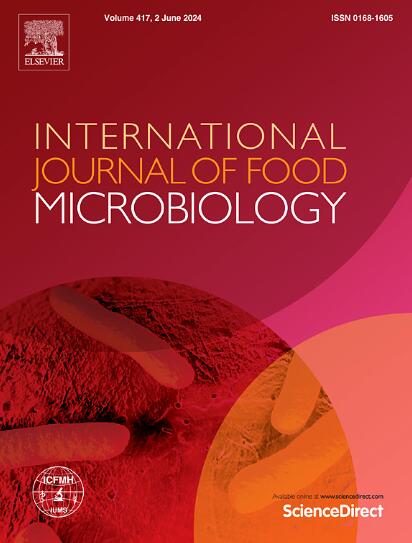缓解苹果采后真菌感染的内生植物柠檬酸双胞菌(Diaporthe citrichinensis)
IF 5.2
1区 农林科学
Q1 FOOD SCIENCE & TECHNOLOGY
International journal of food microbiology
Pub Date : 2025-05-30
DOI:10.1016/j.ijfoodmicro.2025.111289
引用次数: 0
摘要
收获后,苹果容易受到各种真菌病原体的攻击,使其无法食用,进一步降低了其商业价值。为了减轻这些损失,利用内生真菌作为合成杀菌剂的有效替代品的生物防治策略正在获得势头。本研究从家槐不同部位分离得到155种内生真菌。,产自曼迪(喜马偕尔邦)和普尔瓦马(查谟)。克什米尔)。对分离物进行了对苹果采后主要病原菌交替孢霉、黑曲霉、灰霉病菌、扩展青霉、根霉和不均等Venturia的抑菌活性筛选。在双对抗试验中,分离株03MDLP P3-3和01MDLM P1-6对所有目标植物病原菌的抑制率最高。利用夹心实验进一步检查了强效培养物,其中03MDLP P3-3对所有植物病原真菌表现出完全的生长抑制作用,表明其抗真菌功效,可能归因于其释放挥发性有机化合物的能力。通过形态学和分子技术鉴定03MDLP P3-3为柠檬酸Diaporthe citrichinensis。本研究首次从苹果中分离到柑橘内生菌。此外,对强效分离物进行了致病性测试,根据科赫假设,将其引入苹果果实时没有有害影响。在体内条件下考察了枸橼酸霉对苹果果实采后主要真菌病原菌的抑制作用,结果表明,在枸橼酸霉存在的情况下,用病原菌孢子悬浮液接种的试验果实未发生损伤。本研究为利用柠檬酸d作为生物防治剂防治苹果采后真菌病害提供了一条有希望的途径。本文章由计算机程序翻译,如有差异,请以英文原文为准。
Endophytic Diaporthe citrichinensis as a new source to alleviate post-harvest fungal infections in apple (Malus x domestica Borkh.)
After harvesting, Apple is susceptible to being attacked by various fungal pathogens, rendering it unconsumable and further reducing its commercial value. To mitigate these losses, biocontrol strategies utilizing endophytic fungi are gaining momentum as effective alternatives to synthetic fungicides. In the present study, 155 endophytic fungi were isolated from various parts of Malus x domestica Borkh., sourced from Mandi (Himachal Pradesh) and Pulwama (Jammu & Kashmir). The isolates were subjected to screening for antifungal activity against the primary post-harvest pathogens of apple including, Alternaria alternata, Aspergillus niger, Botrytis cinerea, Penicillium expansum, Rhizopus sp., and Venturia inaequalis. In the dual-confrontation test, the isolates 03MDLP P3–3 and 01MDLM P1–6 exhibited the highest percentage inhibition against all target phytopathogens. The potent cultures were further scrutinized using sandwich assay, wherein 03MDLP P3–3 exhibited complete growth inhibition against all phytopathogenic fungi, indicating its antifungal efficacy, likely attributed to its capacity to release volatile organic compounds. Using morphological and molecular techniques, 03MDLP P3–3 was identified as Diaporthe citrichinensis. This study marks the first report of isolating D. citrichinensis as an endophyte from apples. Furthermore, a pathogenicity test was conducted on the potent isolate, revealing no harmful effects when introduced to apple fruits according to the Koch's postulate. The effect of D. citrichinensis was also examined under in vivo conditions against the major post-harvest fungal pathogens of apple fruits, revealing that no lesion development was noted on the test fruits inoculated with spore suspension of pathogens in the presence of D. citrichinensis. The present study offers a promising avenue for utilizing D. citrichinensis as a biocontrol agent to combat post-harvest fungal diseases in apple production.
求助全文
通过发布文献求助,成功后即可免费获取论文全文。
去求助
来源期刊
CiteScore
10.40
自引率
5.60%
发文量
322
审稿时长
65 days
期刊介绍:
The International Journal of Food Microbiology publishes papers dealing with all aspects of food microbiology. Articles must present information that is novel, has high impact and interest, and is of high scientific quality. They should provide scientific or technological advancement in the specific field of interest of the journal and enhance its strong international reputation. Preliminary or confirmatory results as well as contributions not strictly related to food microbiology will not be considered for publication.

 求助内容:
求助内容: 应助结果提醒方式:
应助结果提醒方式:


